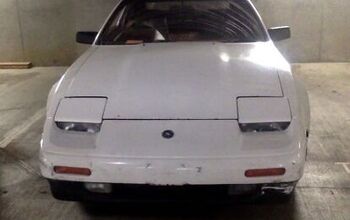Death Race 2005
The battle is joined; the safety nannies have scaled the walls of common sense to patrol the courtyard outside the castle keep. How else can you explain Euro-NCAP's (European New Car Assessment Program) pedestrian safety standards for automobiles? Apparently, it isn't enough that modern cars must coddle their occupants in hyperbaric cocoons, girded by all manner of airbags, crumple zones, seatbelt pretensioners and Silicon Valley chipset wizardry. By the look of things, it's now necessary to legislate OUTSIDE the box, to protect hapless bystanders from Death Race destruction.
Europe's new NCAP testing regime rates a car's ability to protect a pedestrian's body upon contact with the front bumper and hood. Eventually, cars that fail the test will not be allowed for sale within the Euro-Zone. It's yet more proof (if proof were needed) that Brussel's non-elected bureaucrats would have their sponsoring nations consider automobiles a curse that must be controlled, a lethal weapon ready to savage any luckless pedestrian who dares place a stray toe beyond the curb.
Back when NCAP first floated the new standards, carmakers were politely apoplectic. They denounced the new criteria as expensive, impractical and expensive, and, despite their nature as chronic heel draggers when it comes to matters legislative, they had a point. How do you create a car that can lose such a one-sided battle of mass, inertia, momentum and blunt force? Of course, government-mandated necessity being one bad mo fo, automakers playing their wares in the Euro-Zone feverishly concocted various mechanical systems to meet the new NCAP standards– but not without a frightening bill in terms of cost and complexity. A tab passed directly along to… wait for it… the consumer.
French automaker Citroen became the first to answer the dubious ring of NCAP's bell, with the organization declaring the marque's new C6 executive saloon the Jaywalker's Best Friend. In order to secure NCAP's first-ever four-star rating, Citroen fitted their range topper with a prodigious muzzle (clock that front overhang) and a labyrinth of sensors tied to under-hood pyrotechnics. When a lunkheaded pedestrian stumbles out into the roadway and the speeding C6 clips his/her maladroit legs, a network of impact and pressure sensors activate, triggering explosive charges that push the hood upwards, creating an impact buffer zone between the car's hard points and the unfortunate's soft points.
As one might imagine, this is a single-use, blow-it-and-throw-it proposition. Once detonated, one doesn't simply tamp down the hood, thumb a reset switch and get on with it. In addition to whatever cosmetic, structural and driveline damage have been wrought, there will henceforth be new sensors to source, incendiary charges to be refurbish, etc. It all adds up, especially because many of these devices are given to activating during normal front-end collisions, regardless of whether the automobile is impaling itself on another car, a centennial elm, or Angelina Jolie's inestimable stems.
Other solutions being efforted include external airbags, larger front ends with heightened space between engine and sheet metal, thinner body panels with improved give (but inferior dent resistance), and any combination thereof. For cars with abbreviated-by-design front ends (roadsters, minivans, full-size vans, etc.), it is proving particularly troublesome (if not impossible) to meet these standards without an active mechanism component. To crib a Diddyism, 'Mo' money, mo' problems.'
Why should this matter to us Yanks? Both Japan and Australia are about to establish their own pedestrian friendly safety legislation. The automakers mucking about in America's sandbox are busy craning their necks to see how this mess pans out. If the 'soft landing for peds' regs hold abroad, it won't be long before they creep Stateside. Perhaps industry lobbyists will be able to stave off federal implementation for a while, but a cabal of personal injury lawyers– the unscrupulous sort who sue municipalities for millions over potholes when their alcohol-soaked clients stagger from bars into darkened streets with their laces tied together– will eventually make it so.
It's instructive to note that, on average, U.S. footsloggers are far less likely to be smacked (never mind killed) by passing motorists than their worldwide counterparts. For example, the annual number of British pedestrian fatalities is fully seventy-five percent of America's totals, despite the fact that Blighty boasts just one-fifth of our population. Perhaps it's because limeys drive like madmen, or maybe it's attributable to differences in roadway and infrastructure design. More than likely, it's because Americans would just assume drive to their refrigerators than walk, if only their cars could apex the breakfast table.
Regardless, if the U.S. adopts criteria similar to that of the Euro-NCAP, the cost/value relationship between adopting such standards will prove to be even less compelling here than it is abroad, and another battle for personal accountability will be lost.
More by Chris Paukert
Latest Car Reviews
Read moreLatest Product Reviews
Read moreRecent Comments
- Jrhurren Worked in Detroit 18 years, live 20 minutes away. Ren Cen is a gem, but a very terrible design inside. I’m surprised GM stuck it out as long as they did there.
- Carson D I thought that this was going to be a comparison of BFGoodrich's different truck tires.
- Tassos Jong-iL North Korea is saving pokemon cards and amibos to buy GM in 10 years, we hope.
- Formula m Same as Ford, withholding billions in development because they want to rearrange the furniture.
- EV-Guy I would care more about the Detroit downtown core. Who else would possibly be able to occupy this space? GM bought this complex - correct? If they can't fill it, how do they find tenants that can? Is the plan to just tear it down and sell to developers?


































Comments
Join the conversation